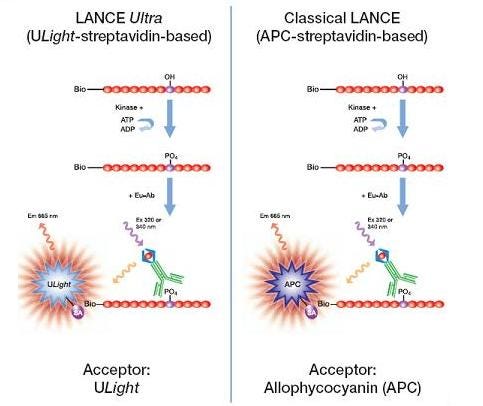
Overview
In a LANCE™ classic format, a biotinylated peptide or protein substrate is typically used. The phosphorylated site is again recognized by an appropriate Europium-labeled anti-phospho antibody. A SureLight™ streptavidin-APC is added to bind the biotinylated sustrate, to provide an APC acceptor fluorophore. This is a 3-component kinase assay (streptavidin-APC, biotinylated substrate, and Eu-anti-phospho antibody), and will require additional assay development steps. You could also use a tagged substrate (GST, His) with one of our anti-tag antibodies. LANCE™ Ultra kinase assays can also be performed as a 4-component assay, if desired.

LANCE TR-FRET 3-component kinase assay configuration.
What do I need to run this assay?
Required reagents available from Revvity:
- Europium-labeled anti-phospho antibody (in addition to our standard catalog antibodies, you can also Label your own LANCE reagent)
- SureLight™ streptavidin-APC (or ULight™-streptavidin)
- 10X LANCE Detection buffer
- Microplate (we recommend white 384-well OptiPlates™ or ProxiPlates™ )
- Seal™-A adhesive plate seal
Required reagents available from various suppliers:
- Kinase
- Biotinylated substrate
- Kinase buffer (basic kinase buffer: 50 mM HEPES pH 7.5, 1 mM EGTA, 10 mM MgCl2, 2 mM DTT, and 0.01% Tween 20. Add any essential kinase supplements, e.g., MnCl2, CaCl2, calmodulin, cGMP, lipids etc. as appropriate for your kinase, if needed).
- EDTA
- ATP
- UltraPure water
Instrumentation/equipment:
- A TRF-capable plate reader
Products and catalog numbers
View a listing of relevant LANCE reagents with catalog numbers.
LANCE Classic kinase assay optimizations
Optimization steps
- Enzyme titration (control, no enzyme)
- Kinetic study (time-course)
- Substrate titration (keep ratio of biotin: streptavidin constant)
- ATP titration
- Biotin: streptavidin ratio titration
- Inhibition curve
- Z' experiment
- Enzyme titration/kinetic time-course: different enzyme concentrations are incubated for a short time-period (e.g., 30 min) with a fixed biotin-peptide concentration (e.g., 1 µM) and a non-limiting ATP concentration (no more than 300 µM, as higher ATP concentrations will negatively affect the LANCE signal). Alternatively, one can conduct reaction progression curves (time-course experiments) at each enzyme concentration to select an incubation time that gives both an acceptable S/B ratio and linear kinetics. If one uses 1 µM biotin-peptide (in the 10-µL kinase reaction volume), then the SA-APC concentration should be fixed at 125 nM in the 20 µL total assay volume.
- Substrate titration: the biotin-peptide is titrated using the optimal enzyme concentration and a non-limiting ATP concentration. Of note, since different biotin-peptide concentrations are used, one must keep the biotin-peptide:SA ratio constant at 4:1. For this, the final SA-APC concentrations are adjusted (e.g., a 500 nM biotin-peptide would require 62.5 nM SA-APC in the 20 µL assay and so on). The biotin-peptide:SA ratio must be kept constant not only to capture all biotin-peptide molecules but also to generate a constant background signal. Keep in mind that the higher the APC concentration, the higher the background signals. Therefore, if one uses a single concentration of SA-APC for all peptide concentrations, the background will be artificially increased for low biotin-peptide concentrations and misleading data will be generated. It is therefore essential to include negative controls (no ATP) for each SA-APC concentration tested in order to correct the signal.
- ATP titration: the ATP is titrated using the optimal enzyme concentration and the selected biotin-peptide concentration (typically less or equal to its Km value). Since a fixed biotin-peptide concentration is used, a single SA-APC concentration is used (again, keep the 4:1 ratio between biotin-peptide and SA-APC).
- Biotin: streptavidin titration: different biotin-peptide:SA-APC ratios are tested (e.g., 8:1, 4:1, 2:1) in order to determine the optimal ratio in terms of S/B and cost. Again, include negative controls (no ATP) for each SA-APC concentration tested in order to correct the signal.
For research use only. Not for use in diagnostic procedures.
The information provided above is solely for informational and research purposes only. Revvity assumes no liability or responsibility for any injuries, losses, or damages resulting from the use or misuse of the provided information, and Revvity assumes no liability for any outcomes resulting from the use or misuse of any recommendations. The information is provided on an "as is" basis without warranties of any kind. Users are responsible for determining the suitability of any recommendations for the user’s particular research. Any recommendations provided by Revvity should not be considered a substitute for a user’s own professional judgment.
Application notes and other resources for LANCE Classic kinase assays
- Application note for a LANCE classic tyrosine kinase assay
- Application note comparing LANCE classic and LANCE Ultra kinase assays
- NIH assay guidance




























